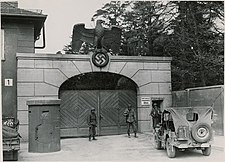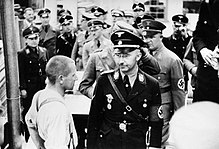World History
Related: About this forumWWII: The Liberation of Dachau Concentration Camp, April 29, 1945, Germany

- U.S. soldiers guarding the main entrance to Dachau just after liberation, 1945.
________
- The Liberation of Dachau, 75 Years Ago, DW News, April 29, 2020. - War Reporter Martha Gellhorn. -
When US soldiers reached the gate of the Dachau concentration camp on April 29, 1945, they had no idea what horrors awaited them. War reporter Martha Gellhorn shared what she saw with the world. On the morning of April 29, 1945 the "Rainbow Division" of the Seventh US Army reached the closed gates of the Dachau concentration camp near Munich. The German Wehrmacht had long since withdrawn, and most of the SS guards were on the run.
Without exchanging fire, the US soldiers entered the camp, and were shocked by what they saw: hundreds of corpses in barracks and freight cars, half-starved traumatized prisoners, many with typhoid. Only a few of them could stand on their own. There was, however, a group of somewhat stronger concentration camp prisoners as well, who, earlier that month, in the chaos of the overcrowded barracks, had conspiratorially formed an underground resistance organization. They introduced themselves to the American GIs as the International Prisoners' Committee.
- The smell of death wafted through the camp: "Behind the barbed wire and the electric fence, the skeletons sat in the sun and searched themselves for lice. They have no age and faces; they all look alike..." wrote American journalist Martha Gellhorn, who as a war reporter, had been accompanying the advancing US troops through occupied Europe since the previous October. A few days later, in the early days of May 1945, she entered the liberated concentration camp and described her shock in her writing: "We crossed the wide, dusty compound between the prison barracks and went to the hospital. In the hall sat more of the skeletons and from them came the smell of disease and death. They watched us but did not move: No expression shows on a face that is only yellowish stubbly skin stretched across bones."
- Reporting from the gates of hell: Since the beginning of the Spanish Civil War in 1936-38, Martha Gellhorn had been reporting for major American newspapers from wars all over the world. She also happened to be the wife of novelist Ernest Hemingway, whom she married in 1940. As an "embedded journalist" she accompanied the US army on the front lines. On April 26, 1945, she and the GIs reached the Allgäu, and in early May, she was sent to the liberated Dachau concentration camp...https://www.dw.com/en/the-liberation-of-dachau-75-years-ago/a-53270700
- Liberating Dachau. Mark Felton Production. The story of the complex events that occurred during liberation of Dachau Camp by the US Army in April 1945.
- More, https://www.jewishvirtuallibrary.org/liberation-film-of-dachau
- Account by the Son of a Rainbow Division Soldier at Dachau, Medium, 2021,
https://billpetro.medium.com/history-of-the-liberation-of-dachau-april-29-1945-95cf278a6263

- Heinrich Himmler, head of the SS (front right, beside prisoner) inspecting Dachau Concentration Camp on 8 May 1936.
- DACHAU was the first concentration camp built by Nazi Germany, opening on 22 March 1933. The camp was initially intended to intern Hitler's political opponents which consisted of: communists, social democrats, and other dissidents. It is located on the grounds of an abandoned munitions factory northeast of the medieval town of Dachau, about 16 km (10 mi) northwest of Munich in the state of Bavaria, in southern Germany. After its opening by Heinrich Himmler, its purpose was enlarged to include forced labor, and, eventually, the imprisonment of Jews, Romani, German and Austrian criminals, and, finally, foreign nationals from countries that Germany occupied or invaded. The Dachau camp system grew to include nearly 100 sub-camps, which were mostly work camps or Arbeitskommandos, and were located throughout southern Germany and Austria. The main camp was liberated by U.S. forces on 29 April 1945.
Prisoners lived in constant fear of brutal treatment and terror detention including standing cells, floggings, the so-called tree or pole hanging, and standing at attention for extremely long periods. There were 32,000 documented deaths at the camp, and thousands that are undocumented. Approximately 10,000 of the 30,000 prisoners were sick at the time of liberation. In the postwar years, the Dachau facility served to hold SS soldiers awaiting trial. After 1948, it held ethnic Germans who had been expelled from eastern Europe and were awaiting resettlement, and also was used for a time as a United States military base during the occupation. It was finally closed in 1960... https://en.wikipedia.org/wiki/Dachau_concentration_camp
hibbing
(10,402 posts)sdfernando
(5,379 posts)Mom and Dad went with 3 kids and came back to the states with 5. Both me and an older brother were born there...well, actually we were born in München but we lived here in Dachau. I don't remember it as I just about 2 when we left and thats probably a good thing. The camp at that time was basically just ruins and in disrepair. My oldest brother (8 years older) and other kids would explore some of the places that were accessible but I really don't think they realized what horrors happened there.
appalachiablue
(42,903 posts)the remains. Do you speak German? I studied it in school but am now rusty.
My father was also an artillery officer, Lt. AAA 7th US Army and at the Dachau liberation when he was 24. One summer when my sister and I returned from Europe, including a visit to Munich, Freiburg and Salzburg he handed me some memorabilia that I've kept ever since - an SS patch possibly from Dachau, some of his insignia and other mementoes.
Although we have few details of his military service I've been researching it more of late. He stayed over with the Army of Occupation in Munchen and had a fairly bad case of battle fatigue when he returned home.